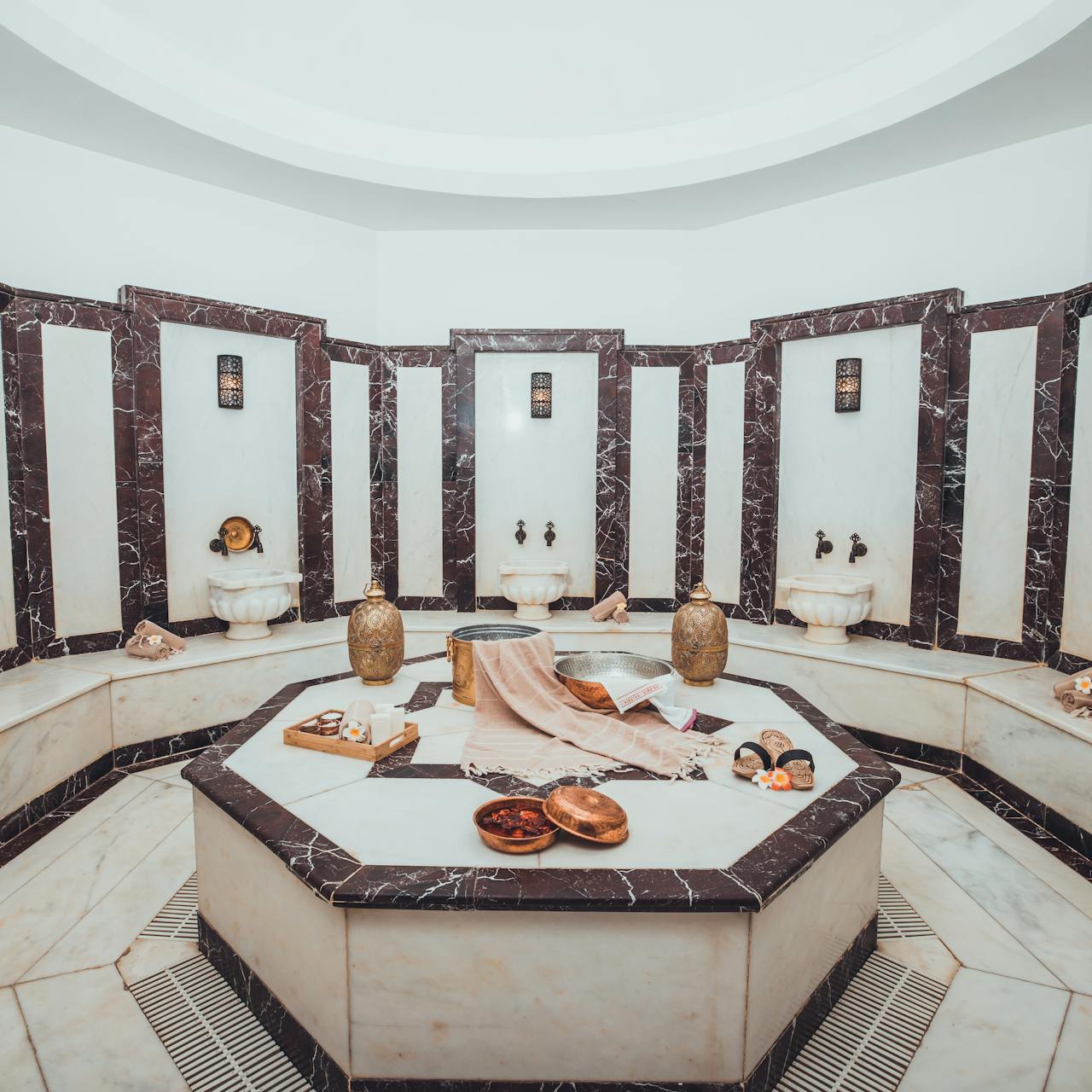
When most people think of a hammam, the image that often comes to mind is that of a luxurious steam bath — warm marble rooms, soothing aromas, and deep relaxation. While this is certainly part of the experience, the hammam’s true significance runs much deeper. In the ancient world, particularly across the Middle East, North Africa, and parts of Europe under Ottoman influence, hammams were more than just places to get clean. They were vibrant social centers — the beating heart of the community — where people gathered, celebrated, and connected.
The Origins of the Hammam
The concept of communal bathing dates back thousands of years. The Greeks and Romans built elaborate public baths that served both hygienic and social purposes. When Islam spread across the Middle East and North Africa, these traditions evolved into what we now know as the hammam, also known as a Turkish or Moroccan bath.
Islamic culture placed a strong emphasis on cleanliness — not only as a matter of health but as a spiritual practice. Ritual purification before prayer (known as wudu) required access to water and clean spaces, and hammams became an essential part of city planning. Every major town or neighborhood featured at least one hammam, often located near mosques, markets, or caravanserais.
A Place of Ritual and Renewal
Stepping into a traditional hammam was like entering a sanctuary. The design itself symbolized a journey — from the cool entrance room where visitors undressed, to the warm chamber that prepared the body, and finally to the hot, steamy core where deep cleansing and exfoliation took place.
But beyond the ritual of bathing, the hammam represented renewal on many levels. It was a space to purify both body and spirit — a transition between the demands of daily life and moments of reflection or social exchange. People came not only to wash but to rejuvenate their minds, share stories, and engage in the collective rhythm of community life.
The Hammam as a Social Hub
In ancient cities, hammams were bustling centers of communication. Long before coffeehouses or modern salons, this was where people gathered to exchange news, discuss politics, and share local gossip. For men, the hammam was a place to network, negotiate business deals, and strengthen community ties.
For women, the hammam held an even more special role. In a time when public spaces were often male-dominated, hammams provided a rare and socially acceptable environment for women to gather freely. They celebrated weddings, births, and religious festivals within those marble walls. A bride-to-be, for instance, would visit the hammam before her wedding in a joyful ceremony filled with music, laughter, and blessings from friends and relatives.
These communal rituals transformed the hammam into a place of belonging and identity — one where social bonds were forged, and traditions were passed down through generations.
Architectural Beauty and Cultural Symbolism
The architecture of old hammams reflected their importance. Many were built with grand domed ceilings pierced by small glass windows that filtered sunlight into soft, star-like patterns. The walls were adorned with intricate mosaics, marble, and geometric designs symbolizing balance and harmony.
This architectural elegance wasn’t just aesthetic — it created a serene and sacred atmosphere, blending practicality with spirituality. The temperature-controlled chambers and water circulation systems were engineering marvels of their time, demonstrating how deeply the art of bathing was woven into urban design.
The Hammam in Modern Times
While the role of hammams has changed with time, their cultural significance endures. In cities like Istanbul, Marrakech, and Damascus, many historic hammams still operate today — not just as tourist attractions but as living reminders of an ancient way of life.
Modern spas around the world have adopted the concept of the hammam, infusing traditional elements like steam, black soap, and exfoliation with contemporary luxury. Yet, even in their modern forms, hammams retain their essence — a place to pause, connect, and restore balance.
Interestingly, the hammam’s communal spirit has seen a quiet revival in recent years. As people seek authentic wellness experiences and meaningful human connections, the hammam’s philosophy of shared rejuvenation feels more relevant than ever. It reminds us that self-care is not just about individual wellness but about community and connection — something ancient societies understood intuitively.
A Legacy of Connection
The old hammams were microcosms of society — places where stories, ideas, and relationships flowed as freely as the water from their marble fountains. They stood at the intersection of health, culture, and spirituality, uniting people through the simple yet profound act of bathing together.
In a modern world often defined by isolation and digital interaction, the hammam’s legacy invites us to rediscover something essential — the power of community, conversation, and shared humanity. Whether nestled in a bustling bazaar or restored as a heritage site, the hammam continues to whisper stories of laughter, warmth, and belonging.
More than just baths, hammams were — and still are — sanctuaries of the soul, reminding us that true cleansing begins not only with water but with connection.





